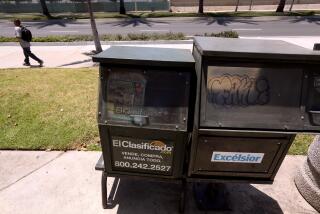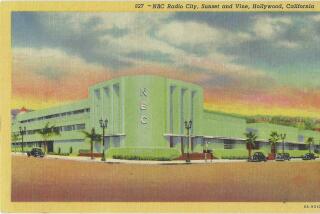How ‘Public’ Is It?
Regarding “Public Radio, Under the Influence” (by Sean Mitchell, May 27):
If I can listen to “A Prairie Home Companion” without having to endure a 53-minute pledge break in the middle of it (as KUSC did one pledge time); if I can get my NPR news relatively uninterrupted by high pressure, nagging, guilt-trips-laid-on pledge breaks, as always seems to happen on KCRW; if I can listen to local news that does not lend itself to video images but to thinking about issues, which never occurs on commercial TV; and if I can listen to thoughtful people talking about serious issues without having to listen to lots of callers with a populist bent (as happens on most “talk radio”); and the only price I have to pay for that is to hear more corporations named--then I say what has happened to KPCC under Minnesota Public Radio’s tenure has been a good thing.
That station now gets the support I used to send to KCRW.
TOM GRIFFITH
Eagle Rock
*
Since the takeover of KPCC by Minnesota Public Radio, the station format has become unbearably bland, with all programs geared toward the same audience, not to mention repetition of programs worthy of some cable TV stations (six hours of “Morning Edition,” 31/2 of “All Things Considered,” and “This American Life,” a perfectly dreary program, played three times each weekend).
KCSN’s signal, with all the truly local programs it has picked up from KPCC and KCRW, unfortunately doesn’t reach me, and by the time it does, it will be because some giant corporation has provided it with the money to expand its range--and corporatize the programming.
CAROL MAY
Los Angeles
*
Mitchell left out a crucial fact about the funding of NPR stations. The membership contributions by listeners pay only for staff salaries and station operating expenses. Essentially all of the non-music programming is paid for by corporate and right-wing endowment fund sponsors. The NPR programmers are not censored. They censor themselves or they are out of work.
KPFK and Pacifica have never accepted a dime from a corporation. While NPR stations cannot survive without their government stipend and corporate program support, the Pacifica stations are 95% funded by their listeners, a figure no NPR station in the country can approach.
Citizens for Independent Public Broadcasting (https://www.cipbonline.org), led by Jerry Starr, is trying to reclaim public radio for the public interest and away from being another corporate billboard. Presently, the only difference NPR offers is a gentle 12th-grade vocabulary instead of the sixth-grade braying heard on the commercial stations.
ALAN NESTLINGER
Santa Ana
*
Perhaps KPFK’s Marc Cooper should look inward before deriding KPCC’s talk shows as “parochial and insipid.”
In truth, it is KPCC’s local and national talk shows that are Southern California’s most diverse and engaging, both in subject matter and in opinions expressed (particularly Larry Mantle’s brilliant “Air Talk”). It is KPFK that tends to the parochial, limited by an openly advertised bent toward the far left and spotty critical thinking.
Furthermore, why does Cooper suggest that KPCC’s increasing coverage of local news is a waste? In an article devoted to the growing homogeny of public radio (a dubious claim), isn’t KPCC’s increasing effort to cover local news a good thing?
GLENN CAMHI
Los Angeles
*
Southern California Public Radio President Bill Davis should update his mental map. I am a longtime member of KPCC who is now spending more time with KCRW. I listen to KPCC for NPR programming and am repelled by the sharp voice of Kitty Felde and the know-it-all presumption of Linda Othenin-Girard.
And only an out-of-towner, indeed, would think that Southern Californians would prefer a Saturday-morning show on money over the raucous good humor of “Car Talk.”
JOY PALMER
Fountain Valley
*
Does KPCC provide comprehensive coverage of the region’s news? No, but who does? Does the station present stories and voices heard nowhere else on L.A. radio? You bet, and it does so while maintaining very high standards of journalism.
As a listener and supporter, I pray its efforts won’t be diluted by a little insecure sniping. The L.A. radio market is plenty big enough for several strong, competitive public stations, and it’s the public that is already benefiting from this healthy competition.
MATHEW R. KAPLAN
Long Beach
*
My compliments to Judy Jankowski for not taking tobacco money donations at KLON.
We need more businesses and charitable organizations who are willing to take a positive stand against tobacco companies. Thank goodness she did not buy into their “good deeds” marketing.
JACQUE PETTERSON
Canyon Country
*
The question not addressed in your article is: How far can public radio and TV stations go--with paid commercials and other aspects of for-profit enterprises--before they are forced to give up their tax-exempt status?
If a public radio station becomes so commercial that it loses its tax-exempt status, the consequence is severe. Donors can no longer take charitable deductions when computing their income taxes. Also, matching donations--where corporate employers match the donations of their employees--generally require the recipient to be tax-exempt.
As a result, a nonprofit broadcaster that loses its tax-exempt status has no choice other than becoming for-profit, shifting its programming accordingly.
Frankly, I would rather pay taxes to keep public radio and TV from becoming commercial.
DAVID E. ROSS
Oak Park


